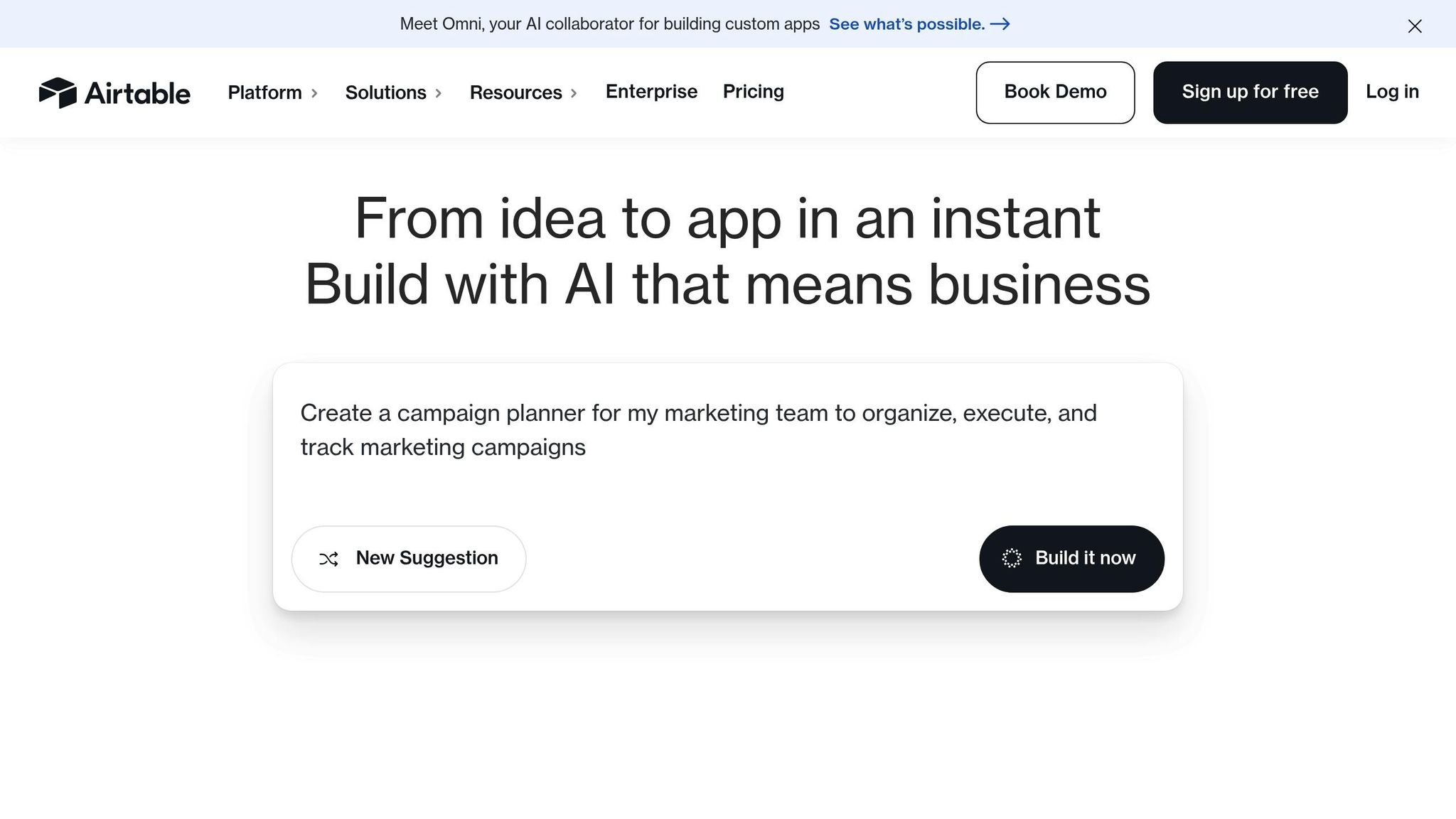- Identify repetitive tasks: Audit your team's daily, weekly, and monthly activities to find tasks that take up time but don't require complex decision-making.
- Prioritize automation: Focus on high-frequency, time-consuming tasks with significant business impact. Organize by frequency, function, and stakeholders.
- Standardize workflows: Create consistent processes, eliminate redundancies, and document every step, including triggers and exception handling.
- Choose the right tools: Look for software that integrates with your systems, supports flexible scheduling, and scales with your business needs.
- Start small: Automate a few simple tasks first, measure results, and expand gradually.
- Monitor and improve: Regularly review performance, track key metrics, and adjust workflows to ensure efficiency.
Automation is not about replacing people but empowering them to focus on tasks that require creativity and critical thinking. Begin with a structured approach, choose tools wisely, and refine processes over time to maximize results.
How to Build Automated Recurring Tasks in Airtable

Find and Sort Your Recurring Tasks
Before diving into automation, it’s essential to pinpoint the tasks that are consuming your team’s time. This starts with a thorough review of your business activities to identify repetitive tasks and then organizing them based on their importance.
Review Your Business Activities
Begin by auditing your team’s weekly and monthly activities to uncover tasks that repeat regularly. Look at both the obvious ones - like data entry - and those that are manual, time-intensive, or prone to errors. These are often prime candidates for automation.
When evaluating tasks, focus on three factors: frequency, complexity, and business impact. For instance, a daily task that saves 30 minutes will likely have a bigger impact than a short, monthly task. On the other hand, highly complex tasks requiring human judgment might not be ready for full automation, but parts of them could still benefit from automated support.
Also, watch out for unclear dependencies - these can delay up to 15% of tasks in typical workflows. Document not only what tasks are performed but also when they happen and how they connect to other processes. This level of detail will be critical when designing automated workflows later.
Sort and Rank Tasks by Priority
Once you’ve identified recurring tasks, organize them to determine which ones should be automated first. Start by grouping tasks based on how often they occur - daily, weekly, monthly, or quarterly. Then, categorize them further by their function (e.g., admin, marketing, finance) and the stakeholders involved (individual, team, or cross-functional).
This categorization can reveal patterns in your operations. For example, you might find that your marketing team spends two hours every Monday updating social media schedules or that your finance team manually processes invoices every month.
Focus on tasks that provide the greatest benefits, such as cutting costs, boosting productivity, or improving quality. To prioritize, calculate the impact by multiplying the time saved by how often the task occurs. For example, a daily task that saves 20 minutes will have a much greater annual impact than a monthly task that saves an hour.
Consider using AI-powered tools to streamline this prioritization process. These tools can evaluate 15–20 variables for each task, compared to the 2–4 variables typically considered in manual methods. With the right setup, AI can achieve up to 92% accuracy in recommending which tasks to automate. Platforms like AI for Businesses offer tools that analyze multiple factors, helping you identify the best opportunities for automation.
Keep in mind that automation works best when it complements human judgment. Some tasks might be perfect for full automation, while others are better suited for a hybrid approach, where automation handles routine steps and humans focus on critical decisions.
To simplify the process, develop a ranking system that weighs both impact and feasibility. High-frequency, high-impact tasks that don’t require complex decision-making should be your top priority. Save the more intricate, judgment-heavy processes for later, once you’ve gained experience with automation.
Create Standard Workflows and Document Them
After prioritizing your tasks, the next step is to establish standardized workflows and document them thoroughly. This ensures that your automation processes operate smoothly and remain manageable over time.
Make Processes Consistent
Consistency is key to effective automation. Automation tools can only perform reliably if the tasks they handle follow a uniform process. This means eliminating variations in how tasks are carried out and creating a single streamlined workflow for each recurring activity.
Start by mapping out the current workflow for each task. Identify and resolve inconsistencies, such as differing approaches to handling refund requests or other routine operations. Once you’ve created a single, optimized process, focus on removing redundancies and bottlenecks that don’t add value. A cleaner, more efficient workflow reduces errors and simplifies automation.
Define clear trigger conditions for each workflow. Instead of vague starting points, use specific criteria, like a support ticket with the subject "billing" and the message containing "incorrect charge." These precise triggers help automation tools recognize when to act without needing manual intervention.
Standardize data formats and naming conventions across all workflows. For example, if one process uses the MM/DD/YYYY date format while another uses DD-MM-YYYY, automation will fail when these processes interact. Similarly, ensure consistency in file naming, folder structures, and data field formats to avoid breakdowns at transition points.
Once workflows are standardized, the next critical step is documenting them clearly.
Write Complete Documentation
Standardized workflows are only as effective as their documentation. Clear, detailed documentation ensures workflows are actionable and easy to follow for both automation tools and team members. It serves as a guide for setting up automation and training your staff.
Document every step of the workflow, even if it seems straightforward. Use screenshots, examples, and sample data to make instructions easier to understand.
Detail all decision points and their logic. For workflows that branch based on conditions, clearly explain the criteria for each path. For example, if invoice approvals vary by amount, specify thresholds like: "Invoices under $500 are auto-approved, $500-$5,000 require manager approval, and over $5,000 need director approval."
Include exception handling procedures to address potential issues. Processes rarely go perfectly every time, so document what to do when things go wrong. For instance, what happens if required fields are missing, a system is down, or a response is delayed? These scenarios help prevent automation from stalling when exceptions occur.
Use simple, consistent language throughout your documentation. Avoid jargon or company-specific terms that might confuse readers or hinder automation tools. Write as though explaining the process to someone unfamiliar with your business. This makes the documentation valuable for onboarding new team members and ensures reliability when setting up automation.
Create visual workflow diagrams alongside written instructions. Flowcharts and process maps make complex tasks easier to grasp and help identify potential issues before automation is implemented. These visuals are also helpful for troubleshooting and refining automated processes.
Finally, keep your documentation up to date. Assign ownership for maintaining it, schedule regular reviews, and store it in a centralized, version-controlled location. Outdated documentation can cause more harm than good by leading to errors and confusion for both people and automation tools.
Choose and Set Up the Right Automation Tools
Once you've established standardized workflows, the next step is finding automation tools that fit seamlessly into your operations. The right tool can transform repetitive tasks into smooth, efficient processes.
Key Features to Look For
When evaluating automation tools, integration should be a top priority. Choose tools that connect effortlessly with your existing systems - whether that’s your CRM, accounting software, or communication platforms. Avoid solutions that require manual data transfers, as they can create bottlenecks instead of eliminating them.
Flexible scheduling options are another must-have. Basic scheduling (like daily or weekly tasks) often isn’t enough. Look for tools that support complex patterns, such as "every third Tuesday of the month" or "quarterly, excluding December." Conditional triggers based on data changes, time zones, or business calendar exceptions ensure your automation adapts to real-world needs.
As your automation scales, user permission controls become increasingly important. Different team members will need different levels of access. For example, your finance team might need full control over invoice processing workflows, while sales reps might only need visibility into lead nurturing sequences.
Don’t overlook error alerts. When automation fails, you need tools that notify you immediately with clear explanations of the problem. Tools that stop working silently can disrupt critical processes like payroll or customer communications.
Scalability is another critical factor. A tool that handles 50 tasks today might struggle with 500 tomorrow. Opt for solutions that maintain performance as complexity grows and offer advanced features like analytics, audit trails, and compliance reporting for future needs.
Finally, consider tools with mobile apps. Business doesn’t stop when you’re away from your desk, and neither should your workflows. Mobile access allows you to approve exceptions, monitor performance, and troubleshoot issues on the go.
These features lay the groundwork for choosing automation tools that integrate seamlessly with your workflows.
Explore Curated AI Tools
To simplify the selection process, consider curated AI tools designed to meet these standards. AI for Businesses offers a directory of proven AI solutions tailored for small to medium-sized enterprises and growing businesses. Using a curated directory reduces the risk of picking tools that are incompatible or unreliable.
For example, tools like Writesonic can streamline content creation workflows, Looka simplifies brand asset creation, and Stability.ai supports image generation for marketing needs. These tools are automation-ready and can help you tackle recurring tasks like content production and visual design.
The directory also ensures that the tools you choose work well together, avoiding the common pitfall of creating a patchwork of incompatible systems. Poorly integrated tools can lead to data silos and manual intervention, undermining the very efficiency you're trying to achieve.
Pricing options include a free Basic plan, a Pro plan at $29/month for full access, and custom Enterprise solutions tailored to larger needs. This structure makes it easier to find the right tools without breaking the bank while ensuring scalability for future growth.
Start Automation Step by Step
Jumping into automation all at once is a common pitfall. It overwhelms teams and often creates more problems than it solves. Instead, take a gradual approach. Start with small, manageable changes that deliver quick results and lay the groundwork for future success.
Begin Small and Expand Over Time
Begin by automating one or two repetitive tasks that have a noticeable impact - think data entry, generating reports, or sending routine emails.
Starting small helps demonstrate the value of automation quickly. As one expert aptly puts it:
"I think the key is: don't try to sell a 'big system' - start with a real pain point and prove impact fast. That's what builds trust in automation." - Crafty-Put4637
sbb-itb-bec6a7e
Track, Review, and Improve Automated Workflows
Setting up automation is just the beginning - the real value lies in keeping an eye on it and making regular adjustments to ensure everything runs smoothly. This means scheduling routine evaluations and using data to refine your processes.
Schedule Regular Check-ins
A monthly review cycle strikes a good balance - it provides enough data to uncover patterns without overwhelming your team with constant updates. These check-ins are the perfect time to pinpoint bottlenecks, eliminate inefficiencies, and uncover areas where your workflows might need fine-tuning.
As your business evolves, so will your automation needs. What worked flawlessly a few months ago might now require adjustments to align with your team’s growth or more complex workflows. Regular reviews give you the opportunity to adapt and streamline processes, ensuring they remain effective.
Use these sessions not just to fix issues but also to simplify. Cutting out unnecessary steps can make a big difference in how smoothly your workflows operate.
Apply Analytics and Reporting Tools
Data is your best friend when it comes to evaluating automation. Keep an eye on key performance indicators (KPIs) like time saved, error rates, task completion rates, and ROI. These metrics give you a clear picture of how well your automation efforts are paying off.
Task management tools can be a goldmine of insights, offering detailed reports on how often tasks are performed and how long they take. With this information, you can see which automated processes are driving the most impact - and which ones might need a second look.
Use these reports to spot trends and make targeted improvements. Whether it’s tweaking a step to reduce processing time or addressing a recurring error, small changes can lead to big efficiency gains. The key is to keep improving and never settle for "good enough".
Prepare for Exceptions and Human Review
Once automated workflows are established and fine-tuned, it's essential to plan for exceptions by incorporating human oversight. While automation can handle a wide range of tasks, there will always be scenarios it can't fully address. By building flexibility into your system and setting up clear escalation pathways, you can ensure your workflows remain effective, even when unexpected challenges arise.
Build in Flexibility
Automation needs to accommodate the unpredictability of real-world conditions - it can't break down at the first sign of an anomaly. To manage this, design workflows that include decision points where processes can pause for human review if certain conditions are met. Use conditional logic to handle routine variations, allowing the system to resolve minor issues automatically. For more complex situations, establish rules to determine when human intervention is required. This balance ensures that your automation can handle common exceptions while flagging unique or critical issues for manual oversight.
Set Up Escalation Procedures
Clear and efficient escalation procedures are vital for addressing exceptions quickly and effectively. Poorly designed escalation systems can lead to delays, but an automated and well-structured approach can significantly reduce resolution times - from an average of 24 hours to under 8 hours.
Start by defining authority levels and documenting thresholds for escalation. Implement time-based triggers to ensure unresolved issues are addressed promptly. To streamline the process, provide managers with all the necessary data, policies, and precedents they need to make informed decisions.
The future of exception handling is leaning toward AI-driven prediction and triage. By documenting patterns in exceptions today, you're building a foundation for smarter, more efficient systems down the road.
Checklist for Automated Recurring Task Management
Use this checklist to ensure your automated recurring task management strategy is thorough and effective.
Task Identification and Planning
- Review all recurring tasks across your teams to get a complete overview.
- Track task durations to identify areas where automation can save the most time.
- Rank tasks by priority based on how often they occur, the time saved, and their overall impact.
- Map out task dependencies to ensure proper sequencing in automation.
- Evaluate complexity to determine which tasks are ready for automation and which might need more preparation.
Workflow Design and Documentation
- Create process maps that outline every step and decision point in a task.
- Document workflows clearly so even non-technical team members can understand them.
- Define inputs and outputs for every automated process.
- Set quality benchmarks and success metrics for each task.
- Plan for errors by including procedures to handle common issues.
Tool Selection and Setup
- Compare automation platforms for their ability to integrate, scale, and ease of use.
- Explore curated AI tools from providers like AI for Businesses to find specialized solutions.
- Check compatibility with your existing systems to avoid integration challenges.
- Ensure strong security measures and data protection features in any tool you choose.
- Calculate the total cost of ownership, including licenses, training, and maintenance.
Implementation Strategy
- Start small by automating simple, low-risk tasks to build confidence.
- Roll out one automation at a time to keep the process manageable for your team.
- Prepare training materials and offer hands-on sessions to help your team adapt.
- Assign clear roles for managing, monitoring, and troubleshooting automated workflows.
- Set realistic timelines that include testing, adjustments, and team adaptation.
Monitoring and Optimization
- Review progress weekly during the first month, then switch to monthly reviews.
- Monitor key metrics like time savings, error rates, and task completion times.
- Log recurring problems and their resolutions to refine processes.
- Collect feedback from team members who interact with the automated systems.
- Update workflows as your business needs change.
Exception Management
- Add conditional logic to workflows to handle routine variations automatically.
- Define escalation triggers for cases that require human input.
- Create detailed escalation procedures with clear authority levels and response times.
- Maintain up-to-date contact lists for escalations.
- Test exception-handling processes regularly to ensure they work as intended.
Maintenance and Growth
- Keep tools and software updated to ensure security and optimal performance.
- Review automation performance quarterly to identify areas for improvement or expansion.
- Analyze exception patterns to refine future automation designs.
- Plan for growth by selecting tools that can scale with your business.
- Stay informed about advancements in automation technology and industry practices.
This checklist will help you maintain and improve your automation strategy as your business evolves.
Conclusion: Main Points to Remember
Automating repetitive tasks requires thoughtful planning, steady implementation, and regular fine-tuning. Businesses that gain the most from automation are those that take the time to fully understand their existing workflows before diving into automation.
Start by reviewing your processes to identify tasks with the greatest potential impact, and make sure all procedures are well-documented and easy to access. Automation works best when you begin with simpler tasks and gradually move into more complex workflows as your system matures.
Once your workflows are mapped out, focus on selecting the right tools. Choosing automation tools wisely is key. Instead of spending endless hours researching, consider using curated directories like AI for Businesses, which highlight AI tools designed for SMEs and growing companies. This approach can streamline the selection process and help uncover tools you might otherwise miss.
Implementing automation takes time and requires setting realistic goals. Start small, track key metrics, and tweak your processes to ensure they remain efficient. Your team will need time to adjust to new workflows, and unexpected challenges are inevitable. Build flexibility into your systems from the outset, and establish clear procedures for when human intervention is needed.
Regular monitoring and updates are essential for creating systems that truly enhance your team's productivity. Schedule routine reviews to assess performance, gather feedback from your team, and identify areas that could use improvement. Automation technology evolves quickly, and your business needs will shift over time. What works well now might need tweaking in the near future.
Finally, remember that automation is meant to complement human decision-making, not replace it. The best systems handle routine tasks effectively while leaving room for creativity, critical thinking, and strategic planning. When you strike this balance, automation becomes more than just a tool for cutting costs - it becomes a driver of growth and innovation.
FAQs
What’s the best way to determine which recurring tasks in my business should be automated?
To figure out which recurring tasks are ripe for automation, take a close look at your workflows and pinpoint tasks that are time-intensive, repetitive, and follow clear rules. Think about processes like data entry, generating invoices, or handling standard customer queries. Tasks that happen often, don’t require much creativity, and significantly impact efficiency tend to be strong contenders for automation.
Weigh the potential advantages of automating these tasks - like cutting down on time spent, minimizing errors, and maintaining consistency. Prioritize processes where automation can make the biggest difference, allowing your team to focus on higher-level, strategic, or creative responsibilities.
What should I consider when choosing automation tools for my team's recurring tasks?
When choosing automation tools, prioritize those that are easy to use, work well with your current systems, and offer customization options to match your team's workflows. A tool that integrates smoothly with your existing software can save time and help avoid unnecessary mistakes.
You’ll also want to assess the tool’s reliability and whether it can scale to meet your future needs. Make sure it can handle both repetitive and more complex tasks effectively. Opting for solutions with dependable customer support and an engaged user community can make troubleshooting much easier.
Focus on tools that boost productivity while staying adaptable to your business’s growth. This way, you’ll get lasting value and keep your operations running efficiently.
How can I keep my automated workflows efficient as my business grows?
To keep your automated workflows running smoothly as your business grows, it’s essential to routinely evaluate and fine-tune your automation systems. This helps ensure they align with shifting business processes, emerging technologies, and evolving operational goals.
Pay close attention to performance metrics, pinpoint any bottlenecks, and make adjustments where needed. Taking a structured approach - like assessing current needs, implementing updates, integrating new tools, and maintaining these systems - can help you stay ahead and keep your workflows effective.
You might also want to explore AI-powered tools to boost your automation capabilities. These tools can simplify tasks, adapt to changing requirements, and enhance overall efficiency, making them a smart choice for businesses looking to scale.


